Numerical Investigation of Climate Change Effects on Storm Surges and Extreme Waves on Canada’s Pacific Coast
Abstract
:1. Introduction
2. Input Data Processing and Analysis
2.1. Bathymetry, Water Levels and Vertical Datum
2.2. Waves—Observations
2.3. Waves—Reanalysis
2.4. Wind and Surface Pressure—Observations
2.5. Wind and Surface Pressure—Reanalysis
2.6. Wind and Surface Pressure—Future Climate
- 2006–2025—Early-century period;
- 2031–2050—Mid-century period; and
- 2080–2099—End-of-century period.
3. Model Development, Calibration and Validation
3.1. Computational Mesh and Boundary
3.2. Boundary Conditions
| a = 0.565 × 10−3 | for | U < 5 m/s |
| a = (−0.12 + 0.137U) × 10−3 | for | 5 < U < 19.22 m/s |
| a = 2.513 × 10−3 | for | U > 19.22 m/s |
3.3. TELEMAC-2D (Storm Surge) Model Input Parameters
3.4. TOMAWAC (Wave) Model Input Parameters
- Bottom friction-induced dissipation—Bouws and Komen [60] expression with default coefficient of 0.038;
- Wave spectrum growth limiter—WAM 4 original limiter [61] with default parameters;
- Depth-induced breaking dissipation—Battjes and Janssen model [64] with default parameters; and
- Nonlinear quadruplet interactions—Discrete Interaction Approximation (DIA) method of Hasselmann et al. [65].
3.5. Model Calibration and Validation
4. Production Simulations
4.1. Hindcast (1979 to 2020)
4.2. Future Climate Scenarios
5. Results—Hindcast of Storm Surges and Extreme Waves
6. Results—Climate Change Impacts on Storm Surges and Extreme Waves
6.1. Storm Surges
6.2. Extreme Waves
7. Data Access and Web Application
8. Limitations and Future Direction
- There is substantial inter-member variability in the GCM-RCM projections of extreme wind speeds, and therefore, so too in the resulting projections of extreme storm surges and waves; particularly in semi-enclosed coastal shelf seas such as the Salish Sea and Chatham Sound (near Prince Rupert). The uncertainty in the projections is poorly constrained, owing to the limited number (four) of GCM-RCM combinations used to drive the storm surge and wave models, and the generally low confidence in climate models’ representation of atmospheric circulation-related aspects of climate change [66]. A larger ensemble of simulations, incorporating atmospheric forcing from a broader range of GCMs and RCMs, and other emissions scenarios, would be beneficial in characterizing uncertainty associated with the projections and different climate futures. Indeed, other researchers have already identified the need for a larger set of wind projections for terrestrial applications in Canada [67]. Higher RCM spatial resolutions are also needed to better characterize atmospheric fields near land-sea interfaces, and in narrow shelf sea regions, considering the steep topography and complex geomorphology of coastal British Columbia.
- The daily temporal resolution of driving atmospheric forcing datasets for the future climate simulations is too coarse to properly resolve extreme storm surge and wave impacts on the coast, particularly in regions with large tidal ranges where the timing of storm surge and wave events on short timeframes relative to high tides or precipitation events (e.g., atmospheric rivers) can have an important influence on flooding, erosion or navigation hazards. Although no attempt is made to predict the frequency or magnitude of these types of compound events over century timescales here, higher resolution atmospheric forcing could enable such analyses. The implicit assumptions here are that daily wind and pressure fields are reasonably representative proxies for the shorter-term atmospheric drivers of extreme storm surges and waves, and that the relationships between daily and sub-daily atmospheric variables remain relatively constant throughout the 21st century. These assumptions are somewhat validated by an analysis of storm wind speed events in the ERA-5 dataset over the period 1979–2018, which revealed a fairly consistent relationship between daily average and 3-hourly wind speeds (i.e., peak 3-hourly wind speeds were 25 ± 13% higher than peak daily averages spanning the storm periods), and no significant trends in the relationship over the reference historical period (based on a linear trend line fit to the data).
- The storm surge and wave projections were limited to a single future climate scenario, which is representative of higher greenhouse gas emissions (RCP8.5). This constraint was imposed by the availability, within the NA-CORDEX web archive, of projections of atmospheric variables at spatial and temporal resolutions approaching those needed to drive the storm surge and wave models. Multi-model surface wind and pressure projections at 0.22° spatial resolution and daily temporal resolution were available only for the RCP8.5 scenario. An expanded database of high resolution atmospheric projections, spanning all five Shared Socioeconomic Pathways in the Sixth Assessment Report of the Intergovernmental Panel on Climate Change [68], would allow for the impacts of other climate futures on storm surges and waves to be assessed.
- The storm surge model’s skill in predicting historical water level anomalies is negatively affected by the exclusion of baroclinic effects and ocean basin-scale dynamical effects. The model results demonstrating that storm surges in shelf seas are dominated by remote forcing underscore the importance of considering large-scale water level variability and steric effects when evaluating extreme water levels. This is particularly true in the context of developing extreme water level projections for future climate scenarios, given the dominant influence of climate variability events such as El Niño-La Niña Southern Oscillation on regional water level anomalies [22]. Zhai et al. [21] demonstrated that steric and large-scale ocean water level variability can be incorporated in regional storm surge models through boundary forcing derived from global ocean model products. Future improvements on this approach likely involve further convergence of ocean modelling and coastal modelling expertise and technologies, to simulate key processes contributing to water level anomalies over global or basin-wide spatial scales, while taking advantage of unstructured computational meshes to achieve the requisite high spatial resolutions needed in shelf seas (e.g., [69]).
- Pacific Ocean climate variability patterns significantly influence storm surge and wave climates in Canada’s west coast region [22]. In particular, ENSO is expected to remain a dominant driver of inter-annual variability in the future [68]. However, despite some slight improvements in recent years [68], GCM projections of the future frequency and intensity of El Niño events remain highly uncertain [22]. Continued research and development of global earth system models and their ability to predict climate variability patterns such as ENSO are needed to support improved projections of storm surges and waves in Canada’s west coast region, and to allow for similar methodologies to be applied in other world regions.
9. Conclusions
Author Contributions
Funding
Institutional Review Board Statement
Informed Consent Statement
Data Availability Statement
Acknowledgments
Conflicts of Interest
References
- Murphy, E.; Osborne, P.; Clohan, D. Water Level and Tsunami Design Criteria for LNG Marine Terminals in BC. In Proceedings of the 14th Triennial International Conference, New Orleans, LA, USA, 12–15 June 2016. [Google Scholar]
- Vancouver Fraser Port Authority. Guidelines—Shoreline Protection (Vancouver Harbour) Inspection, Maintenance, Design and Repair; Engineering and Maintenance Department: Vancouver, BC, Canada, 2018. [Google Scholar]
- Global Container Terminals Canada. Deltaport Expansion Berth Four (DP4)—Detailed Project Description; British Columbia Environmental Assessment Office: Victoria, BC, Canada, 2021. [Google Scholar]
- Institute for Catastrophic Loss Reduction. Addressing Climate Risk for Coastal Transportation Infrastructure: Opportunities Moving Forward; Institute for Catastrophic Loss Reduction: Toronto, ON, Canada, 2018. [Google Scholar]
- Lyle, T.; Long, G.; Beaudrie, C. City of Vancouver Coastal Flood Risk Assessment—Phase 2 Final Report; City of Vancouver: Vancouver, BC, Canada, 2015. [Google Scholar]
- Northwest Hydraulic Consultants Ltd. Lower Mainland Flood Management Strategy Project 2: Regional Assessment of Flood Vulnerability; Fraser Basin Council: Vancouver, BC, Canada, 2016. [Google Scholar]
- Vadeboncoeur, N. Perspectives on Canada’s West Coast Region. In Canada’s Marine Coasts in a Changing Climate; Government of Canada: Ottawa, ON, Canada, 2016; pp. 207–252. [Google Scholar]
- EnviCom Working Group 178. Climate Change Adaptation Planning for Ports and Inland Waterways; PIANC: Bruxelles, Belgium, 2020. [Google Scholar]
- Greenan, B.; James, T.; Loder, J.; Pepin, P.; Azetsu-Scott, K.; Ianson, D.; Hamme, R.; Gilbert, D.; Tremblay, J.-E.; Wang, X.; et al. Changes in Oceans Surrounding Canada. In Canada’s Changing Climate Report; Government of Canada: Ottawa, ON, Canada, 2018; p. 444. [Google Scholar]
- James, T.; Henton, J.; Leonard, L.; Darlington, A.; Forbes, D.; Craymer, M. Relative Sea-Level Projections in Canada and the Adjacent Mainland United States; Government of Canada: Ottawa, ON, Canada, 2014. [Google Scholar]
- James, T.; Robin, C.; Henton, J.; Craymer, M. Relative Sea-Level Projections for Canada Based on the IPCC Fifth Assessment Report and the NAD83v70VG National Crustal Velocity Model; Geological Survey of Canada: Ottawa, ON, Canada, 2021. [Google Scholar]
- Soontiens, N.; Allen, S.; Latornell, D.; Souëf, K.L.; Machuca, I.; Paquin, J.-P.; Lu, Y.; Thompson, K.; Korabel, V. Storm Surges in the Strait of Georgia Simulated with a Regional Model. Atmosphere-Ocean 2016, 54, 1–21. [Google Scholar] [CrossRef]
- Forseth, P. Adaptation to Sea Level Rise in Metro Vancouver: A Review of Literature for Historical Sea Level Flooding and Projected Sea Level Rise in Metro Vancouver; Simon Fraser University: Burnaby, BC, Canada, 2012. [Google Scholar]
- Walker, I.J.; Sydneysmith, R. From Impacts to Adaptation: Canada in a Changing Climate 2007; Lemmen, D.S., Warren, F.J., Lacroix, J., Bush, E., Eds.; Government of Canada: Ottawa, ON, Canada, 2008. [Google Scholar]
- Chang, S.E.; Brown, A.J.; Costa, R.; Dobson, B.; Dowlatabadi, H.; Haukaas, T. A Community Resilience Approach to Assessing Transportation Risk in Disasters. In Proceedings of the 16th World Conference on Earthquake Engineering, Santiago, Chile, 9–13 January 2017. [Google Scholar]
- Murty, T.S.; Venkatesh, S.; Danard, M.B.; El-Sabh, M. Storm Surges in Canadian Waters. Atmosphere-Ocean 1995, 33, 359–387. [Google Scholar] [CrossRef]
- Khandekar, M.L.; Swail, V.R. Storm Waves in Canadian Waters: A Major Marine Hazard. Atmosphere-Ocean 1995, 33, 329–357. [Google Scholar] [CrossRef]
- Anderson, J.R.; Gyakum, J.R. A Diagnostic Study of Pacific Basin Circulation Regimes as Determined from Extratropical Cyclone Tracks. Mon. Weather Rev. 1989, 117, 2672–2686. [Google Scholar] [CrossRef] [Green Version]
- Bromirski, P.; Flick, R.; Miller, A. Storm Surge along the Pacific Coast of North America. J. Geophys. Res. Oceans 2017, 122, 441–457. [Google Scholar] [CrossRef]
- Bromirski, P.D.; Flick, R.E.; Cayan, D.R. Storminess Variability along the California Coast. J. Clim. 2003, 16, 982–993. [Google Scholar] [CrossRef]
- Zhai, L.; Greenan, B.; Thomson, R.; Tinis, S. Use of Oceanic Reanalysis to Improve Estimates of Extreme Storm Surge. J. Atmos. Ocean. Technol. 2019, 36, 2205–2219. [Google Scholar] [CrossRef]
- Barnard, P.; Short, A.; Harley, M.; Splinter, K.; Vitousek, S.; Turner, I.; Allan, J.; Banno, M.; Bryan, K.; Doria, A.; et al. Coastal Vulnerability across the Pacific Dominated by El Nino/Southern Oscillation. Nat. Geosci. 2015, 8, 801–807. [Google Scholar] [CrossRef]
- 105 Missing Containers Tossed from Ship during B.C. Storm Have Likely Sunk: Coast Guard. Available online: https://www.cbc.ca/news/canada/british-columbia/lost-containers-from-freighter-mv-kingston-have-likely-sunk-1.6245797 (accessed on 10 January 2022).
- It’s Been One Year since a Windstorm Blew a Hole in White Rock’s Historic Pier. Available online: https://www.cbc.ca/news/canada/british-columbia/white-rock-pier-windstorm-anniversary-1.5404977 (accessed on 10 January 2022).
- Storm: Historic “bomb Cyclone” Leads to Dozens of Ferry Cancellations, Power Outages. Available online: https://bc.ctvnews.ca/b-c-storm-historic-bomb-cyclone-leads-to-dozens-of-ferry-cancellations-power-outages-1.5636935 (accessed on 10 January 2022).
- Coast Guard Monitoring 22 Vessels Damaged or Destroyed in B.C. Storm. Available online: https://bc.ctvnews.ca/coast-guard-monitoring-22-vessels-damaged-or-destroyed-in-b-c-storm-1.5672673 (accessed on 10 January 2022).
- Assessing Storm Damage on Seawall, Piers to Take Weeks: Vancouver Park Board. Available online: https://bc.ctvnews.ca/assessing-storm-damage-on-seawall-piers-to-take-weeks-vancouver-park-board-1.5736443 (accessed on 10 January 2022).
- Crean, P.; Murty, T.; Stronach, J. Numerical Simulation of Oceanographic Processes in the Waters between Vancouver Island and the Mainland. Oceanogr. Mar. Biol. 1988, 26, 11–142. [Google Scholar]
- Yang, Z.; Wang, T.; Castrucci, L.; Miller, I. Modeling Assessment of Storm Surge in the Salish Sea. Estuar. Coast. Shelf Sci. 2020, 238, 106552. [Google Scholar] [CrossRef]
- Milbrandt, J.; Bélair, S.; Faucher, M.; Vallée, M.; Carrera, M.; Glazer, A. The Pan-Canadian High Resolution (2.5 Km) Deterministic Prediction System. Weather Forecast. 2016, 31, 1791–1816. [Google Scholar] [CrossRef]
- Saha, S.; Moorthi, S.; Pan, H.; Wu, X.; Wang, J.; Nadiga, S.; Tripp, P.; Kistler, R.; Woollen, J.; Behringer, D.; et al. The NCEP Climate Forecast System Reanalysis. Bull. Am. Meteorol. Soc. 2010, 91, 1015–1057. [Google Scholar] [CrossRef]
- Reikard, G.; Robertson, B.; Buckham, B.; Bidlot, J.; Hiles, C. Simulating and Forecasting Ocean Wave Energy in Western Canada. Ocean Eng. 2015, 103, 223–236. [Google Scholar] [CrossRef]
- Hiles, C.; Buckham, B.; Wild, P.; Robertson, B. Wave Energy Resources near Hot Springs Cove, Canada. Renew. Energy 2014, 71, 598–608. [Google Scholar] [CrossRef]
- Robertson, B.R.D.; Hiles, C.E.; Buckham, B.J. Characterizing the near Shore Wave Energy Resource on the West Coast of Vancouver Island, Canada. Renew. Energy 2014, 71, 665–678. [Google Scholar] [CrossRef]
- Vitousek, S.; Barnard, P.; Fletcher, C.; Frazer, N.; Erikson, L.; Storlazzi, C. Doubling of Coastal Flooding Frequency within Decades Due to Sea-Level Rise. Nat. Sci. Rep. 2017, 7, 1399. [Google Scholar] [CrossRef] [PubMed]
- Morim, J.; Hemer, M.; Wang, X.; Cartwright, N.; Trenham, C.; Semedo, A.; Young, I.; Bricheno, L.; Camus, P.; Casas-Prat, M.; et al. Robustness and Uncertainties in Global Multivariate Wind-Wave Climate Projections. Nat. Clim. Chang. 2019, 9, 711–718. [Google Scholar] [CrossRef] [Green Version]
- Morim, J.; Trenham, C.; Hemer, M.; Wang, X.; Mori, N.; Casas-Prat, M.; Semedo, A.; Shimura, T.; Timmermans, B.; Camus, P.; et al. A Global Ensemble of Ocean Wave Climate Projections from CMIP5-Driven Models. Nat. Sci. Data 2020, 7, 105. [Google Scholar] [CrossRef]
- Bernier, N.; Thompson, K.; Ou, J.; Ritchie, H. Mapping the Return Periods of Extreme Sea Levels: Allowing for Short Sea Level Records, Seasonality, and Climate Change. Glob. Planet. Chang. 2006, 57, 139–150. [Google Scholar] [CrossRef]
- Casas-Prat, M.; Wang, X. Projections of Extreme Ocean Waves in the Arctic and Potential Implications for Coastal Inundation and Erosion. J. Geophys. Res. Oceans 2020, 125, e2019JC015745. [Google Scholar] [CrossRef]
- Hersbach, H.; Bell, B.; Berrisford, P.; Hirahara, S.; Horányi, A.; Muñoz-Sabater, J.; Nicolas, J.; Peubey, C.; Radu, R.; Schepers, D.; et al. The ERA5 Global Reanalysis. Q. J. R. Meteorol. Soc. 2020, 146, 19. [Google Scholar] [CrossRef]
- Fisheries and Oceans Canada Canadian Hydrographic Service Non-Navigational (NONNA-100) Bathymetric Data. Available online: https://open.canada.ca/data/en/dataset/d3881c4c-650d-4070-bf9b-1e00aabf0a1d (accessed on 10 January 2022).
- GEBCO The GEBCO_2020 Grid. Available online: https://www.gebco.net/data_and_products/gridded_bathymetry_data/ (accessed on 10 January 2022).
- Fisheries and Oceans Canada Tides, Currents, and Water Levels. Available online: http://www.tides.gc.ca/eng (accessed on 10 January 2022).
- Foreman, M.G.G. Manual for Tidal Heights Analysis and Prediction; Institute of Ocean Sciences, Department of Fisheries and Oceans: Sidney, BC, Canada, 1977. [Google Scholar]
- Ponte, R. Nonequilibrium Response of the Global Ocean to the 5-Day RossbyHaurwitz Wave in Atmospheric Surface Pressure. J. Phys. Oceanogr. 1997, 27, 2158–2168. [Google Scholar] [CrossRef]
- Ecosystem and Oceans Science, Department of Fisheries and Oceans Canada Marine Environmental Data Section Archive. Available online: https://meds-sdmm.dfo-mpo.gc.ca (accessed on 10 January 2022).
- Swail, V.R.; Cardone, V.; Ferguson, M.; Gummer, D.; Harris, E.; Orelup, E.; Cox, A. The MSC50 Wind and Wave Reanalysis. In Proceedings of the 9th International Workshop On Wave Hindcasting and Forecasting, Victoria, BC, Canada, 24–29 September 2006. [Google Scholar]
- Environment and Climate Change Canada Historical Climate Data. Available online: https://climate.weather.gc.ca/ (accessed on 10 January 2022).
- C.C.C.S. (C3S) ERA5: Fifth Generation of ECMWF Atmospheric Reanalyses of the Global Climate. Available online: https://cds.climate.copernicus.eu/cdsapp#!/home (accessed on 10 January 2022).
- Taylor, K. Summarizing Multiple Aspects of Model Performance in a Single Diagram. J. Geophys. Res. 2001, 106, 7183–7192. [Google Scholar] [CrossRef]
- Mearns, L.; McGinnis, S.; Korytina, D.; Arritt, R.; Biner, S.; Bukovsky, M.; Chang, H.-I.; Christensen, O.; Herzmann, D.; Jiao, Y.; et al. The NA-CORDEX Dataset, Version 1.0. NCAR Clim. Data Gatew. 2017. [Google Scholar] [CrossRef]
- I. P.C.C. Climate Change 2013: The Physical Science Basis. Contribution of Working Group I to the Fifth Assessment Report of the Intergovernmental Panel on Climate Change; Cambridge University Press: Cambridge, UK, 2013. [Google Scholar]
- Hervouet, J.-M. Hydrodynamics of Free Surface Flows: Modelling with the Finite Element Method; John Wiley & Sons, Ltd: Hoboken, NJ, USA, 2007. [Google Scholar]
- Ata, R. TELEMAC-2D V8p0 User Manual. Available online: http://www.opentelemac.org/ (accessed on 10 January 2022).
- Hawk, T. Tomawac V8p0 User Manual. Available online: http://www.opentelemac.org/index.php/manuals (accessed on 10 January 2022).
- Remacle, J.-F.; Geuzaine, C. Gmsh: A 3-D Finite Element Mesh Generator with Built-in Pre- and Post-Processing Facilities. Int. J. Numer. Methods Eng. 2009, 79, 1309–1331. [Google Scholar]
- OpenStreetMap. Available online: https://osmdata.openstreetmap.de/ (accessed on 10 January 2022).
- Flather, R.A. Results from a Storm Surge Prediction Model of the North-West European Continental Shelf for April, November and December; Scripps Institution of Oceanography: San Diego, CA, USA, 1976; 37p. [Google Scholar]
- Egbert, G.; Erofeeva, S. Efficient Inverse Modeling of Barotropic Ocean Tides. J. Atmos. Ocean. Technol. 2002, 19, 183–204. [Google Scholar] [CrossRef] [Green Version]
- Bouws, E.; Komen, G.J. On the Balance between Growth and Dissipation in an Extreme Depth-Limited Wind-Sea in the Southern North Sea. J. Phys. Oceanogr. 1983, 13, 1653–1658. [Google Scholar] [CrossRef] [Green Version]
- The Wamdi Group. The WAM-Model—A Third Generation Ocean Wave Prediction Model. J. Phys. Oceanogr. 1988, 18, 1775–1810. [Google Scholar] [CrossRef] [Green Version]
- Komen, G.; Hasselmann, S.; Hasselmann, K. On the Existence of a Fully Developed Wind-Sea Spectrum. J. Phys. Ocean. 1984, 14, 1271–1285. [Google Scholar] [CrossRef]
- Janssen, P. Quasi-Linear Theory of Wind-Wave Generation Applied to Wave Forecasting. J. Phys. Ocean. 1991, 21, 1631–1642. [Google Scholar] [CrossRef] [Green Version]
- Battjes, J.; Janssen, J. Energy Loss and Set-up Due to Breaking of Random Waves. In Proceedings of the 16th International Conference on Coastal Engineering, Hamburg, Germany, 27 August–3 September 1978; pp. 569–587. [Google Scholar]
- Hasselmann, S.; Hasselmann, K.; Allender, J.; Barnett, T. Computations and Parameterizations of the Nonlinear Energy Transfer in Gravity-Wave Spectrum. Part II: Parameterizations of the Nonlinear Energy Transfer for Application in Wave Models. J. Phys. Ocean. 1985, 15, 1378–1391. [Google Scholar] [CrossRef] [Green Version]
- Shepherd, T. Atmospheric Circulation as a Source of Uncertainty in Climate Change Projections. Nat. Geosci. 2014, 7, 703–708. [Google Scholar] [CrossRef]
- Jeong, D.; Sushama, L. Projected Changes to Mean and Extreme Surface Wind Speeds for North America Based on Regional Climate Model Simulations. Atmosphere 2019, 10, 497. [Google Scholar] [CrossRef] [Green Version]
- IPCC. Climate Change 2021: The Physical Science Basis. Contribution of Working Group I to the Sixth Assessment Report of the Intergovernmental Panel on Climate Change; Cambridge University Press: Cambridge, UK, 2021. [Google Scholar]
- Kirezci, E.; Young, I.; Ranasinghe, R.; Muis, S.; Nicholls, R.; Lincke, D.; Hinkel, J. Projections of Global-Scale Extreme Sea Levels and Resulting Episodic Coastal Flooding over the 21st Century. Sci. Rep. 2020, 10, 11629. [Google Scholar] [CrossRef]
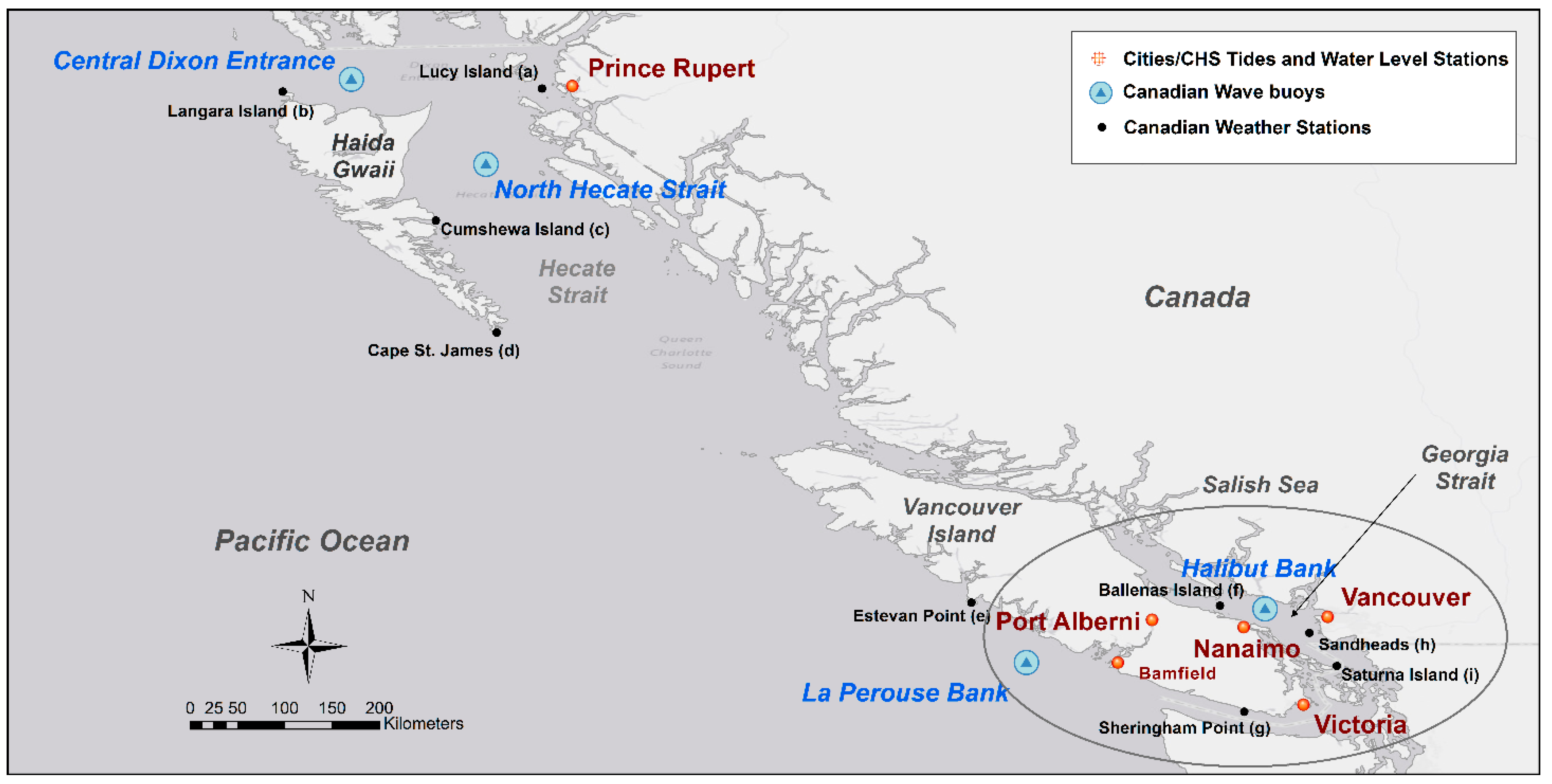

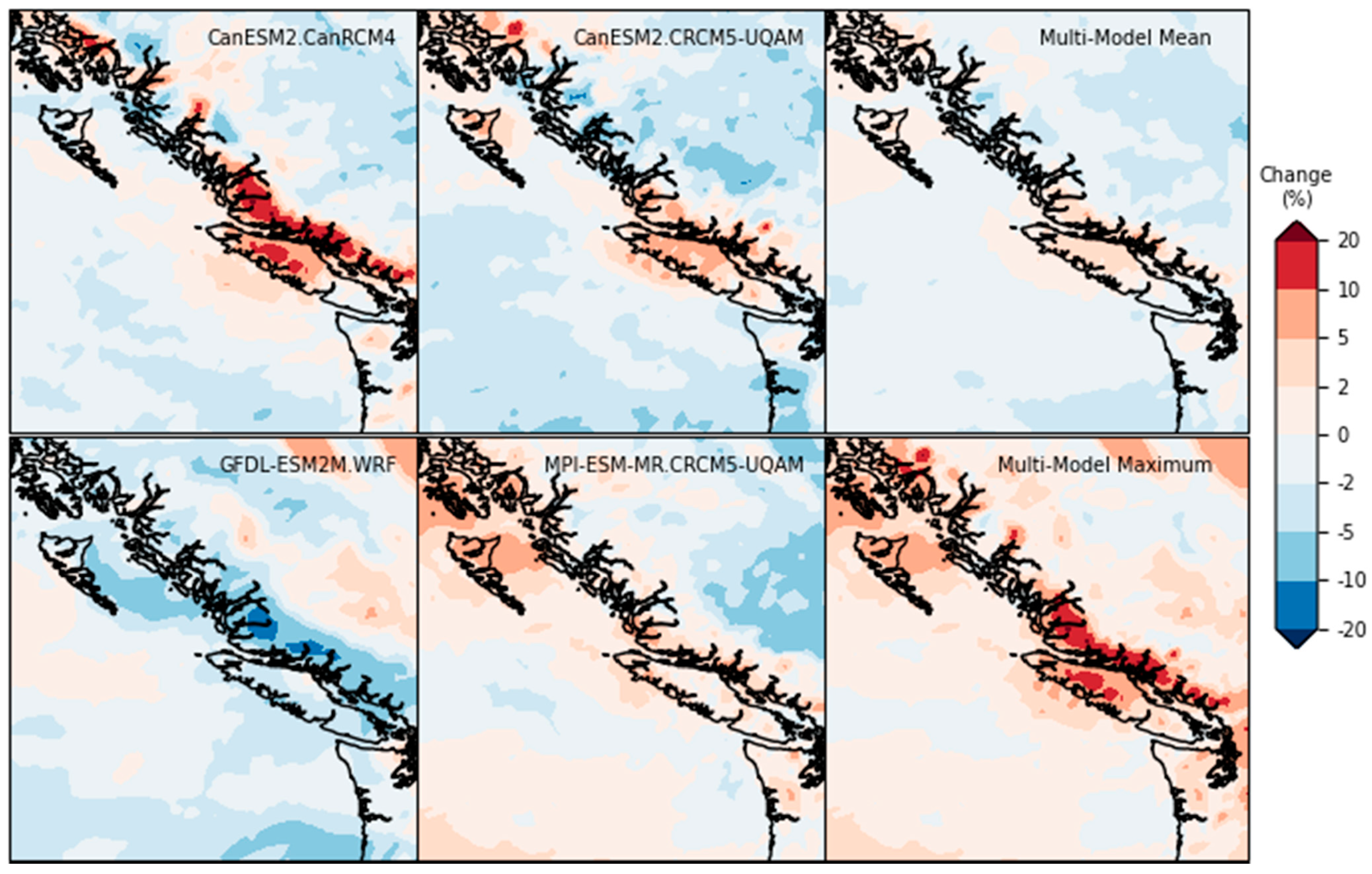
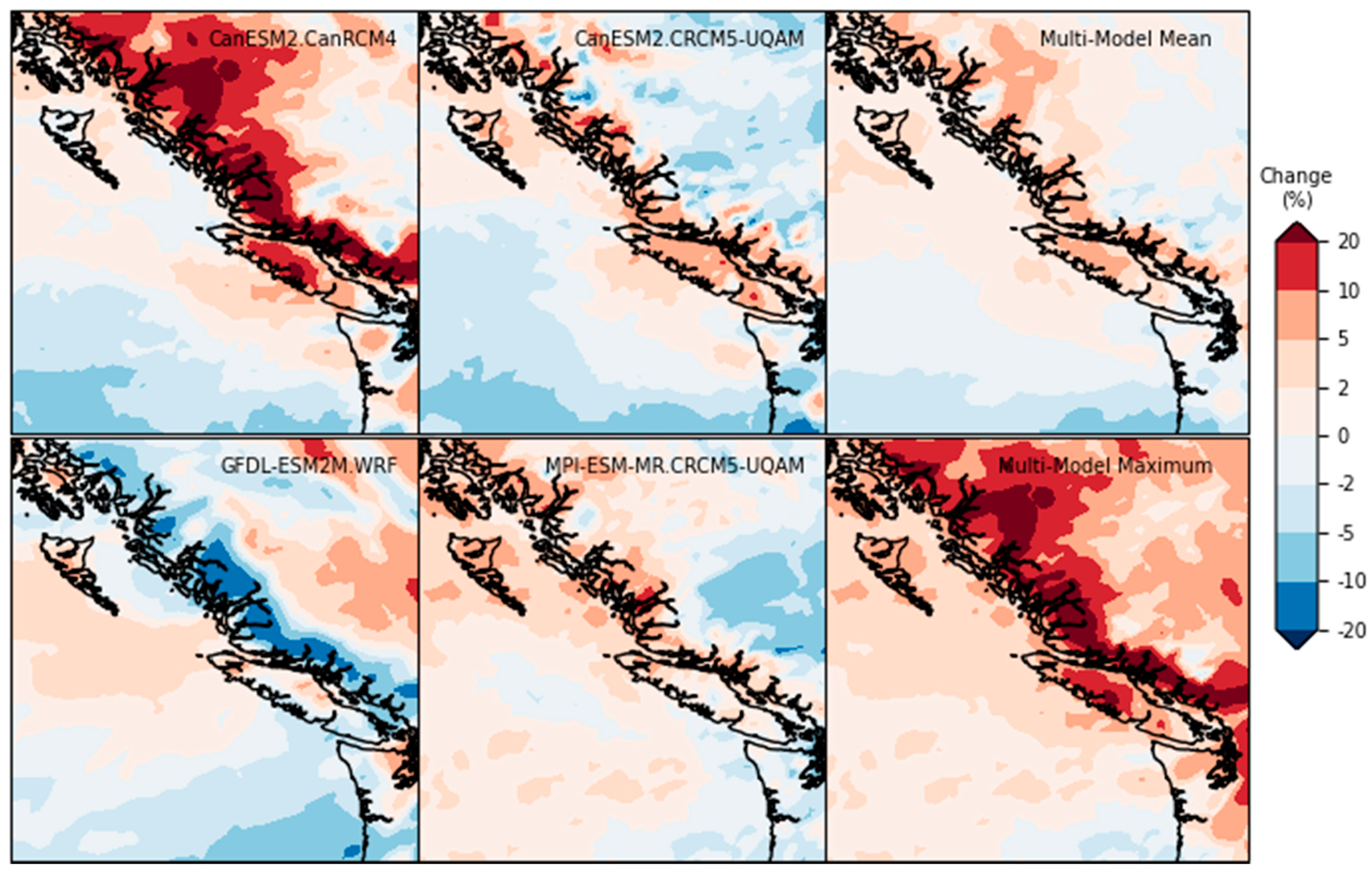
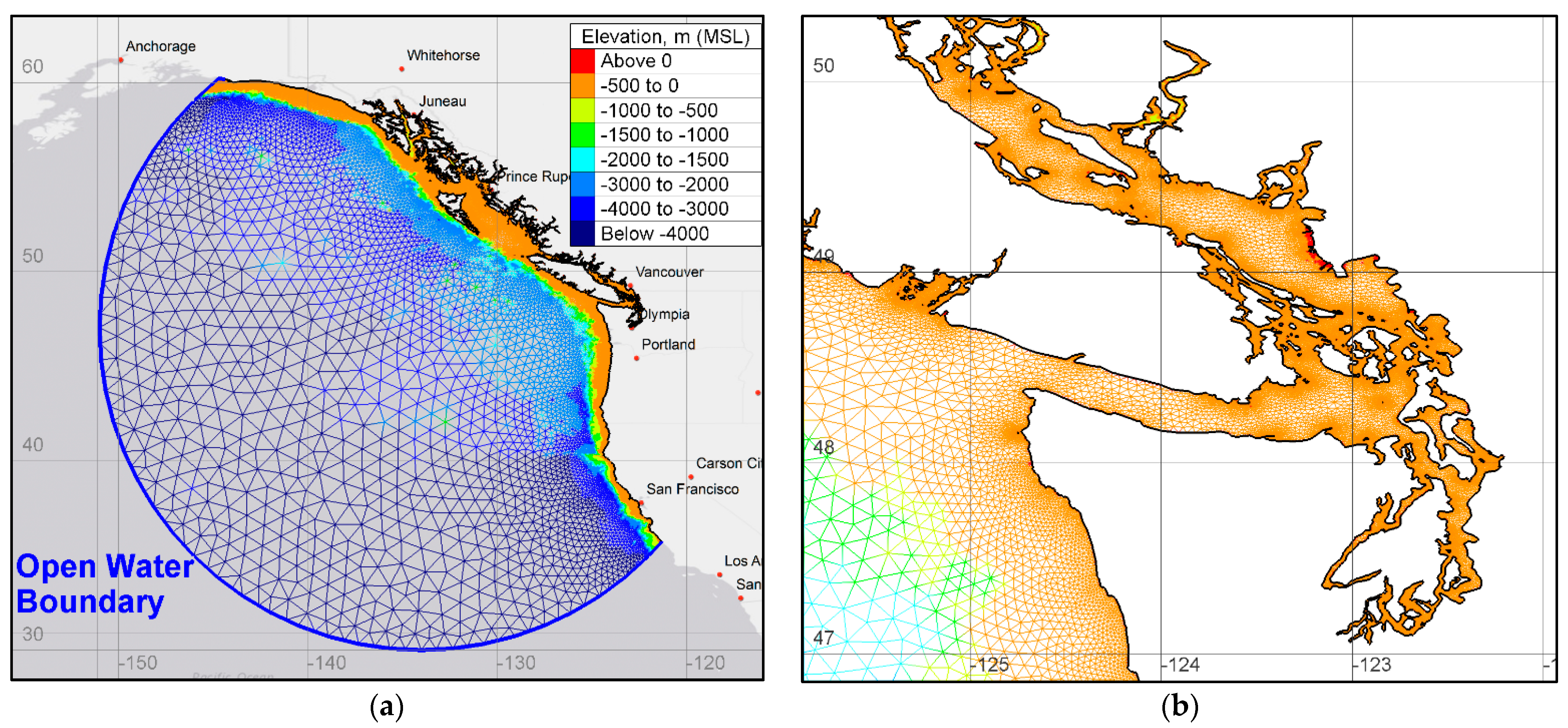



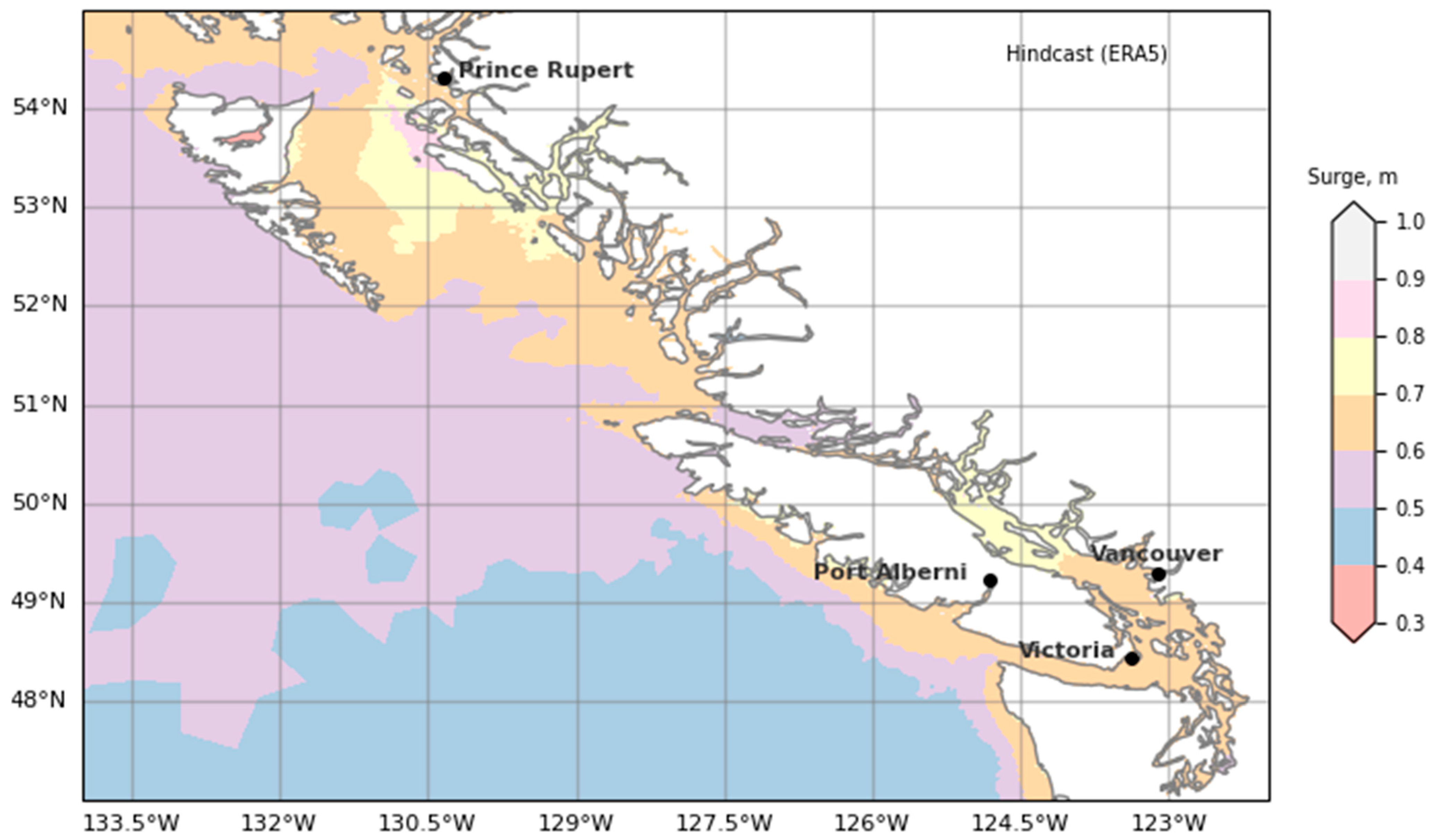
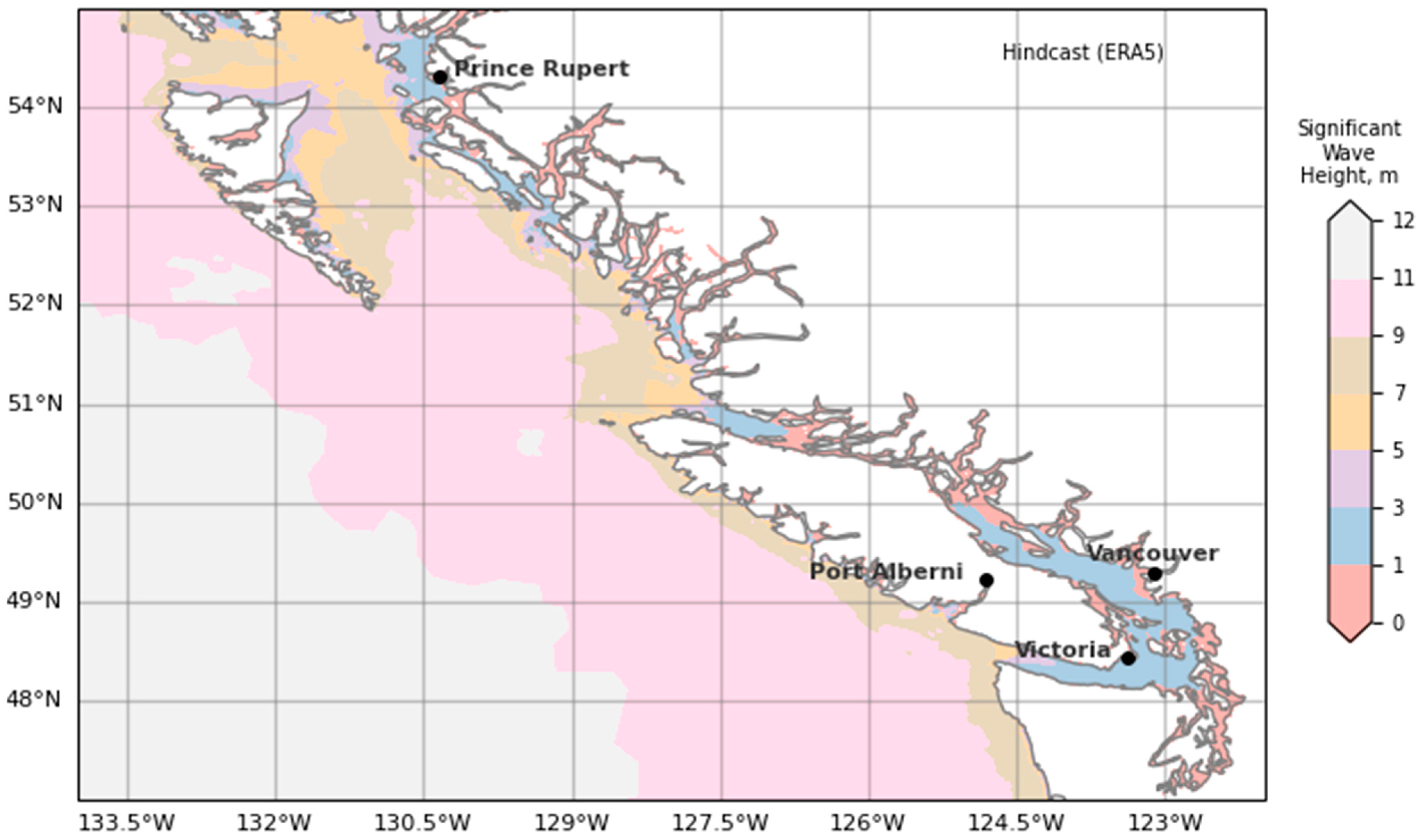
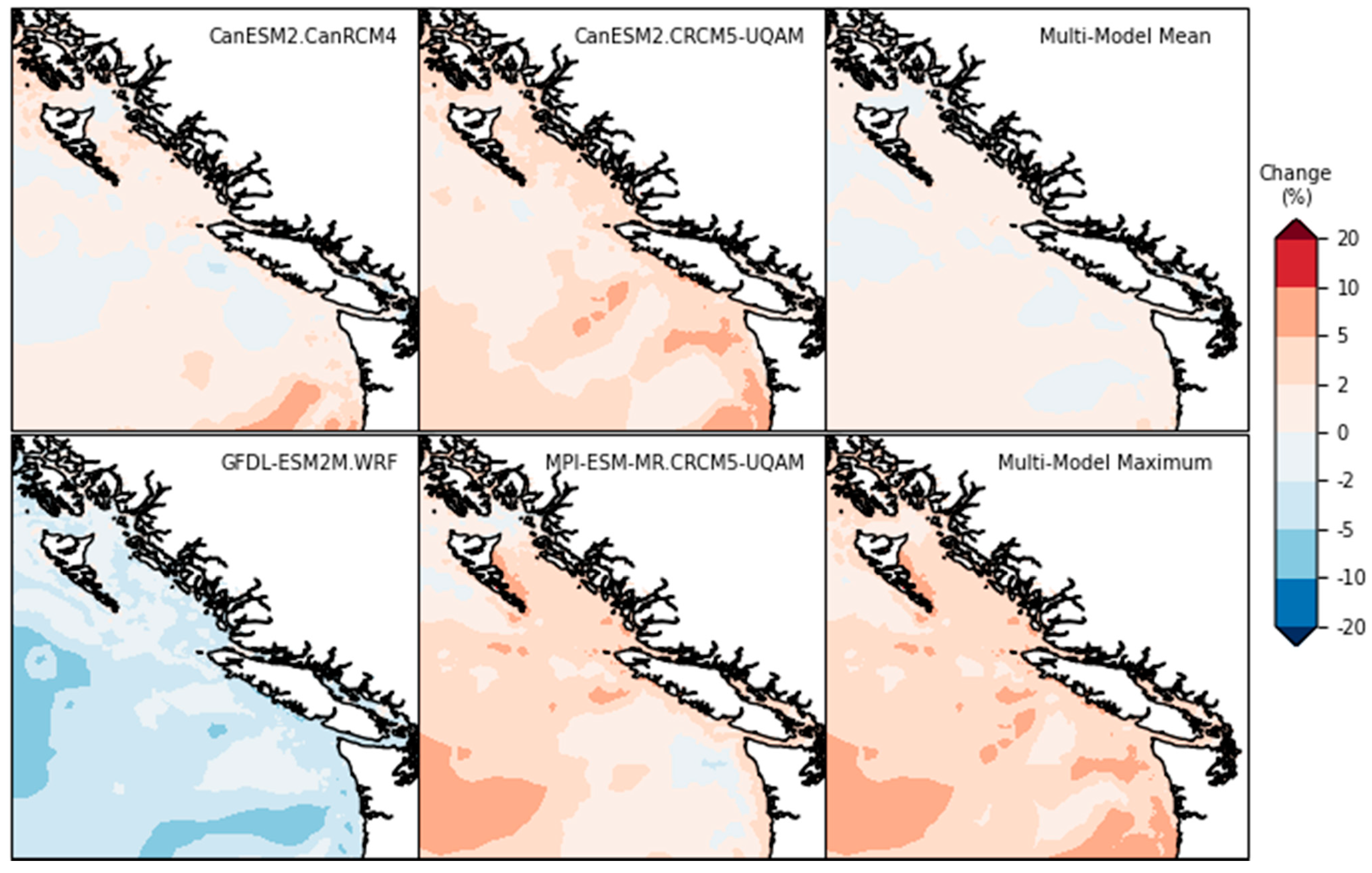

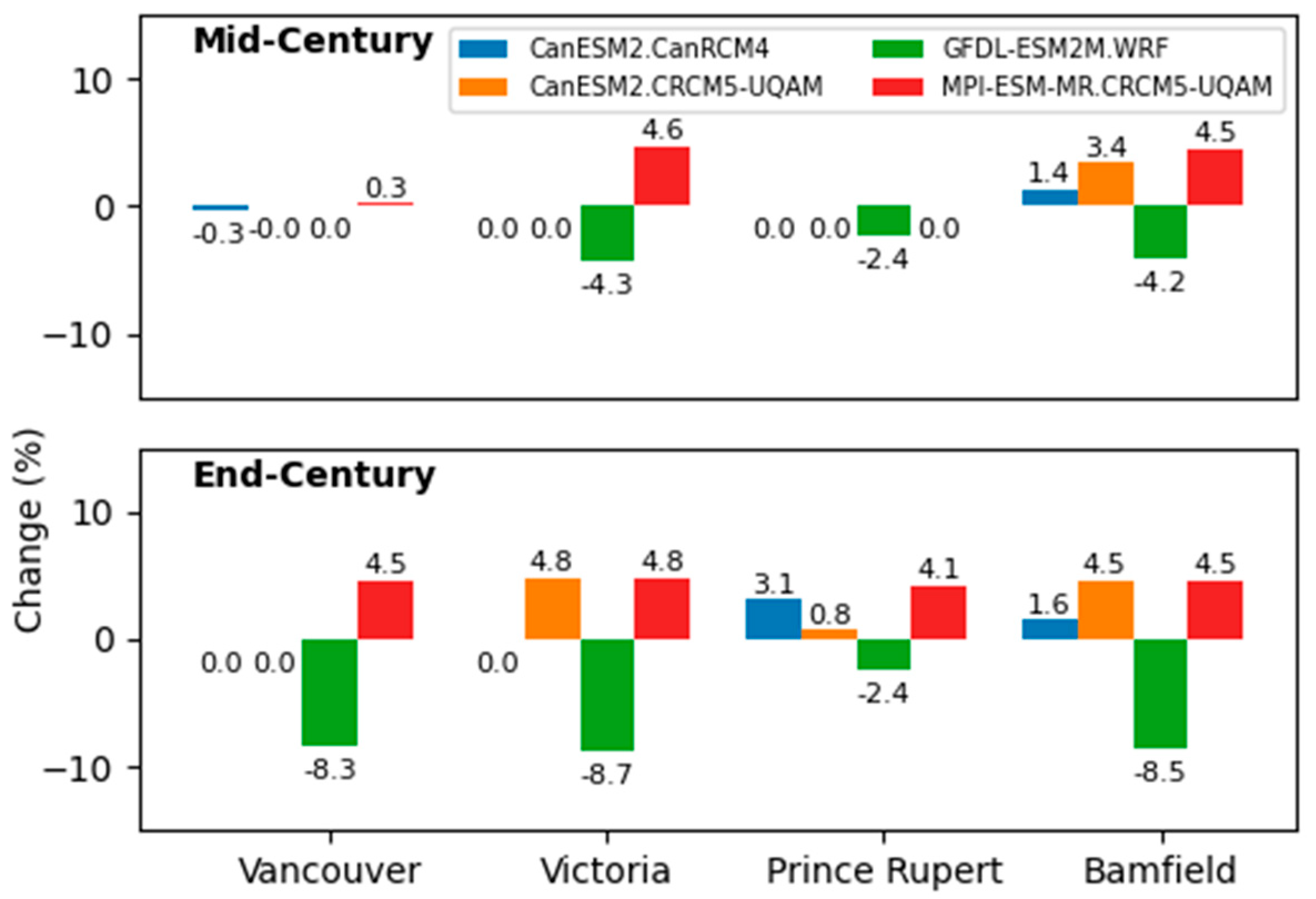
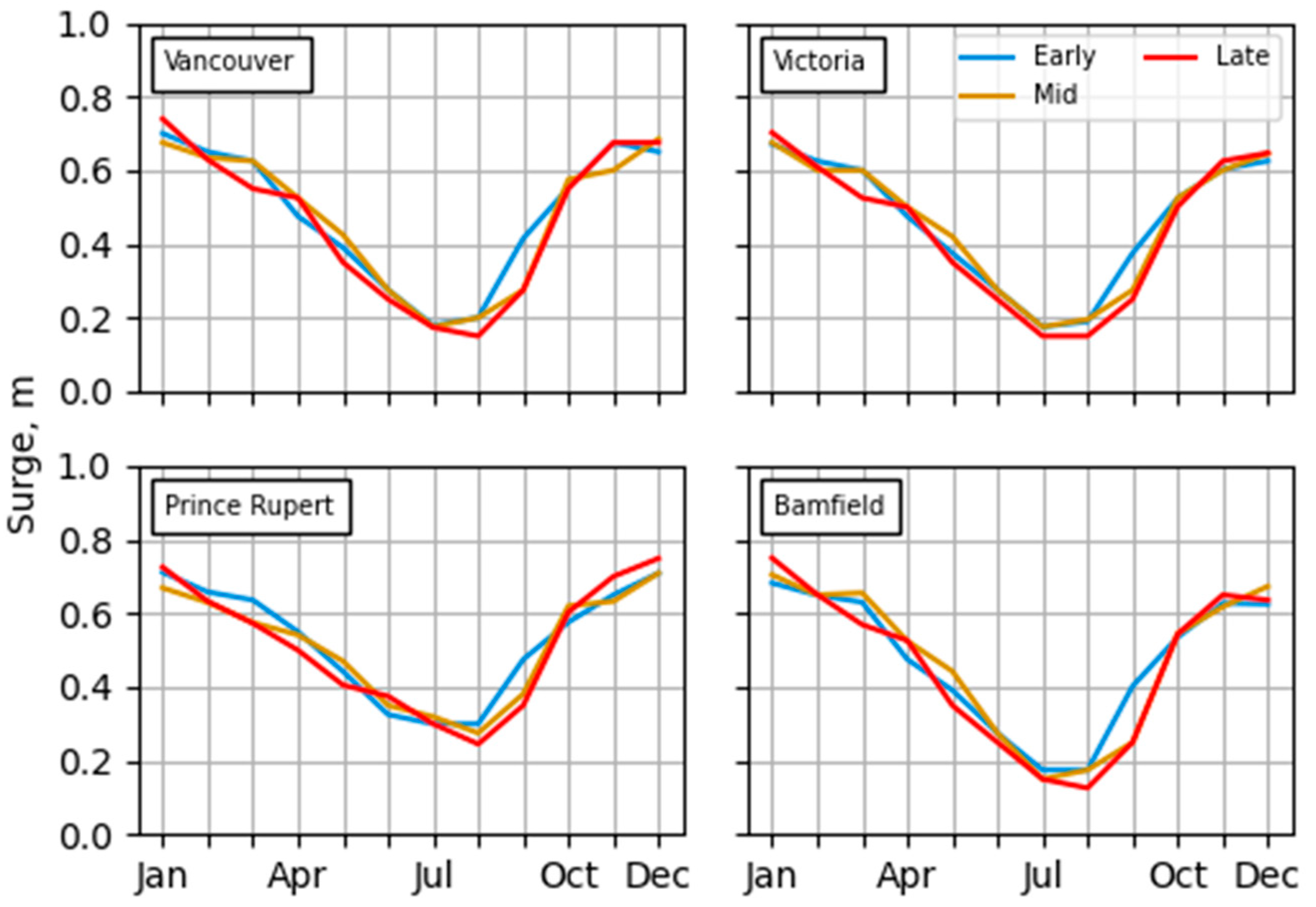
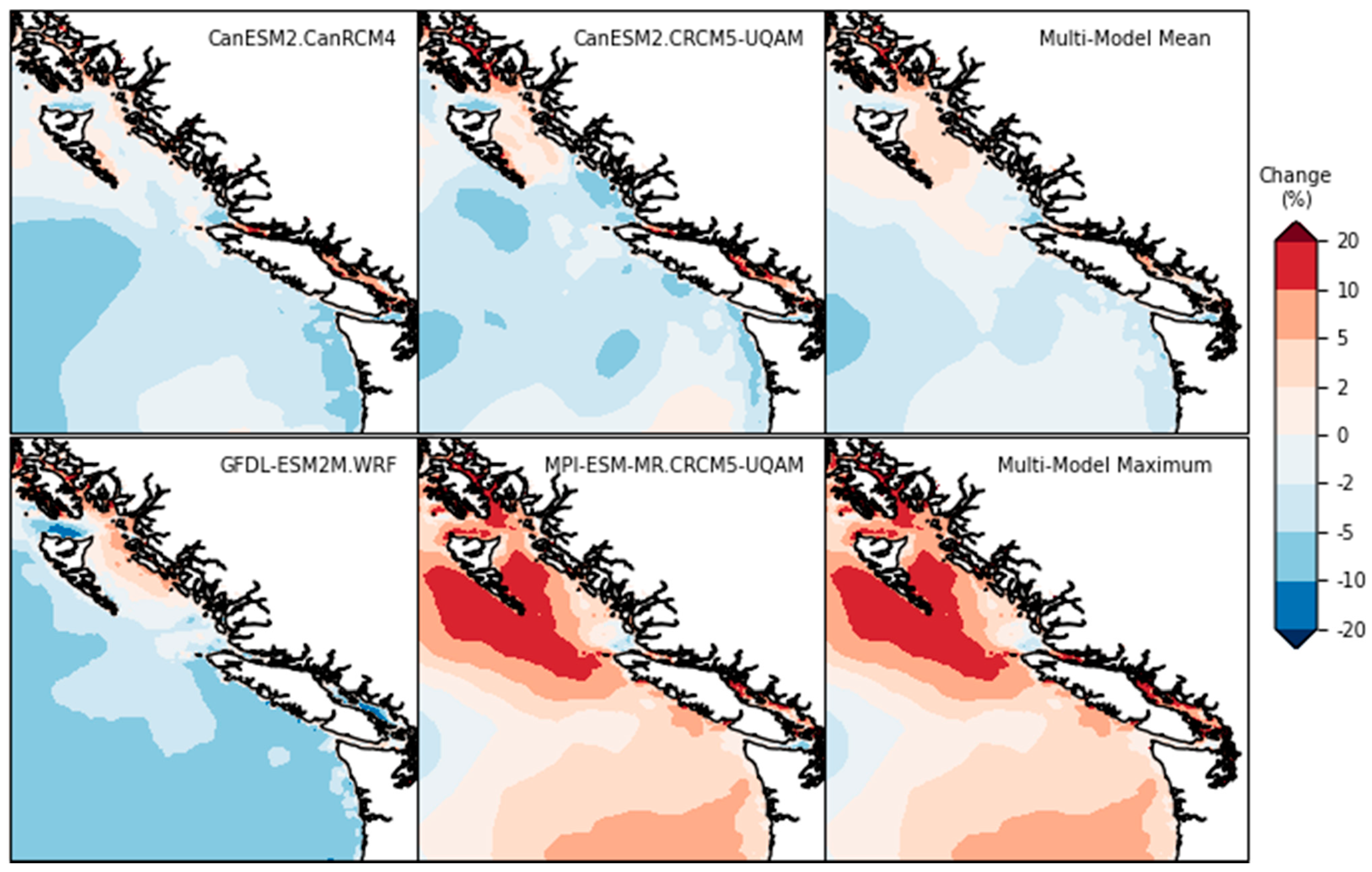

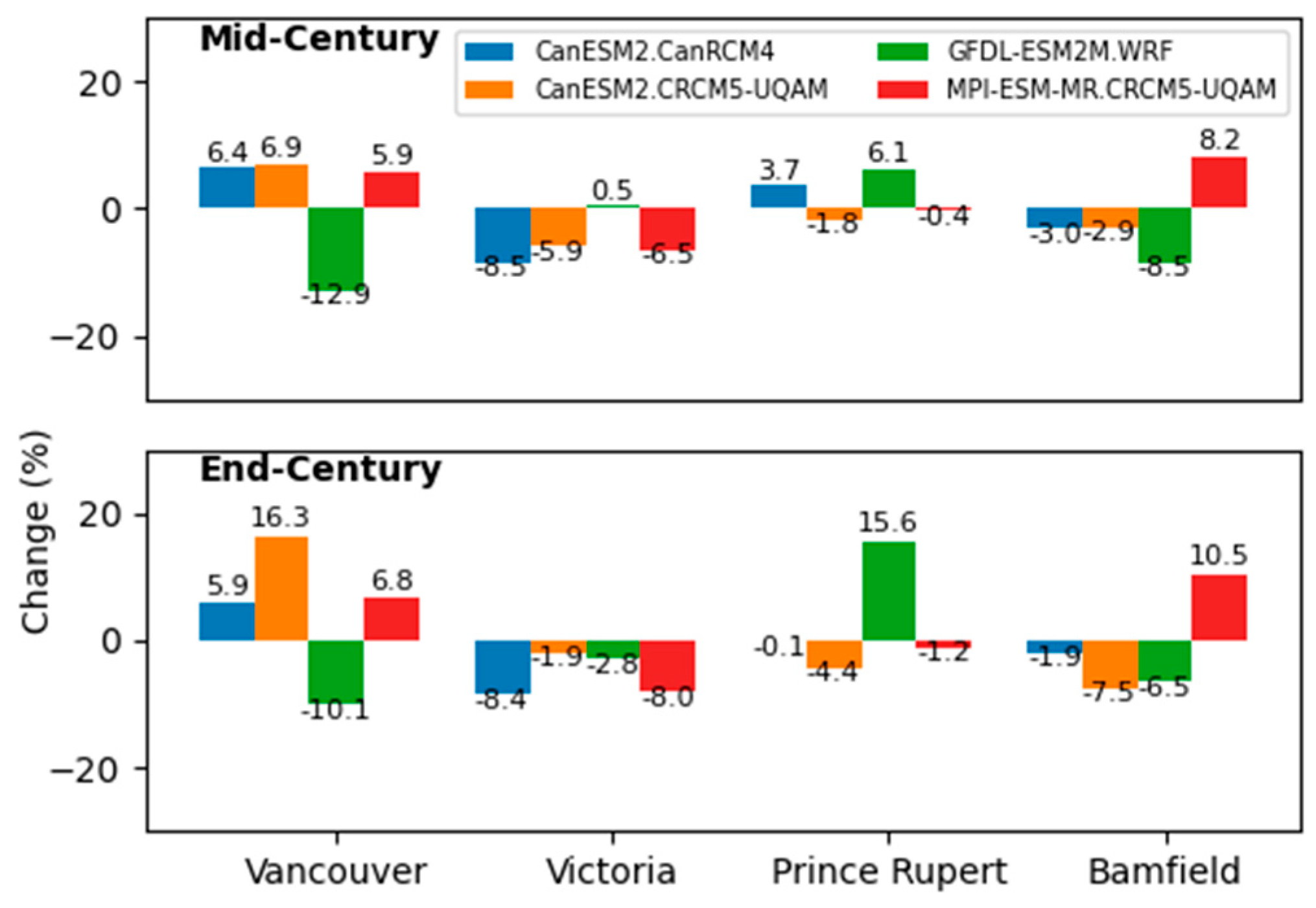
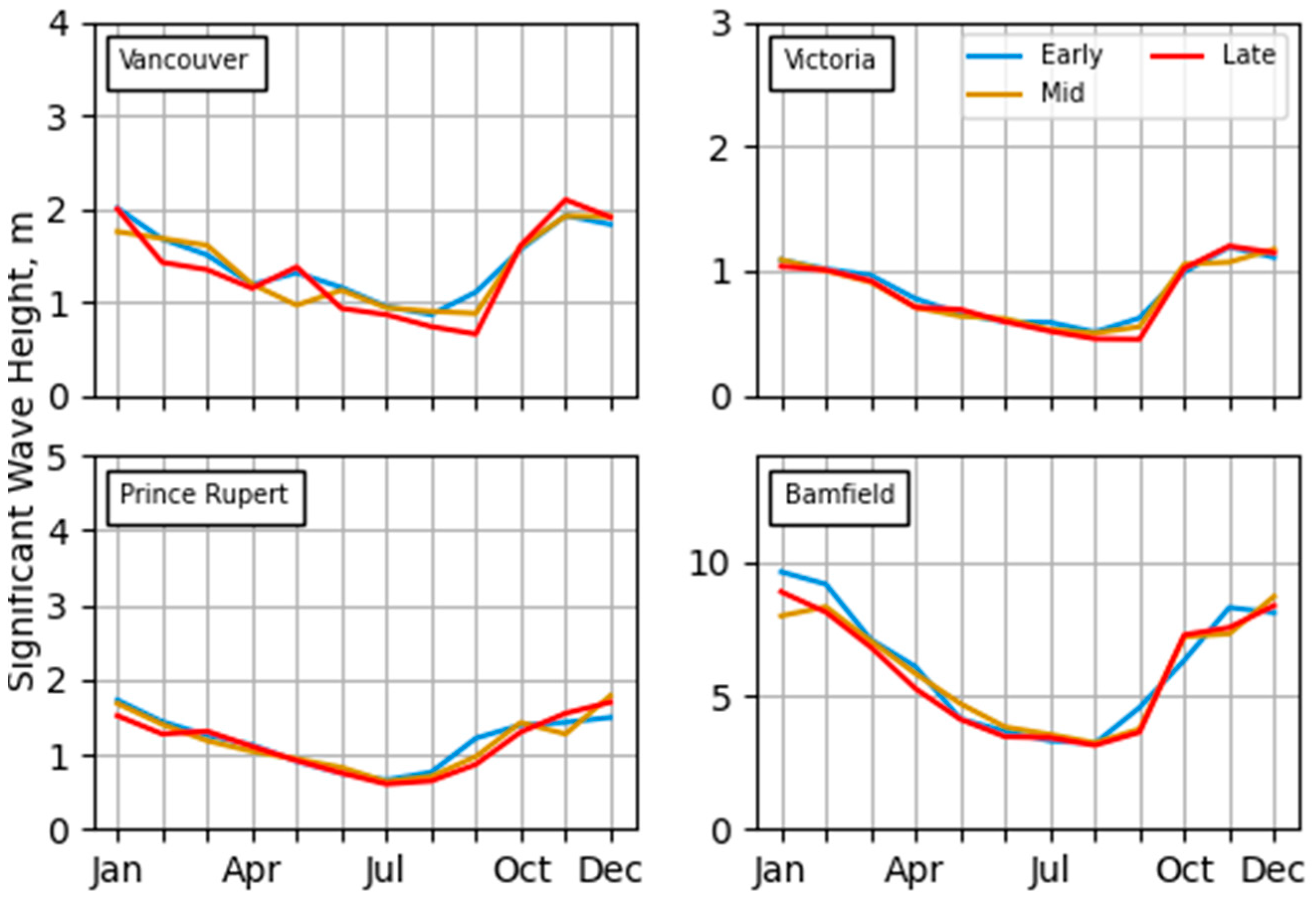
| Global Climate Model | Regional Climate Model | Institution |
|---|---|---|
| CanESM2 | CanRCM4 | Canadian Centre for Climate Modelling & Analysis |
| CanESM2 | CRCM5-UQAM | Université du Québec à Montréal |
| MPI-ESM-MR | CRCM5-UQAM | Université du Québec à Montréal |
| GFDL-ESM2M | WRF | University of Arizona/US National Center for Atmospheric Research (NCAR) |
| Storm Surge | Significant Wave Height | ||||||
|---|---|---|---|---|---|---|---|
| Period | Tide Gauge | r2 | RMSE (m) | Period | Wave Buoy | r2 | RMSE (m) |
| Feb. 1992 | Bamfield | 0.88 | 0.08 | Dec. 1993 | La Perouse Bank | 0.90 | 0.91 |
| Prince Rupert | 0.77 | 0.10 | North Hectate Strait | 0.91 | 0.81 | ||
| Victoria | 0.82 | 0.07 | Halibut Bank | 0.94 | 0.2 | ||
| Vancouver | 0.91 | 0.07 | Central Dixon Ent. | 0.64 | 0.91 | ||
| Dec. 1987 | Bamfield | 0.93 | 0.06 | Dec. 1996 | La Perouse Bank | 0.84 | 0.97 |
| Prince Rupert | 0.86 | 0.11 | North Hectate Strait | 0.92 | 0.71 | ||
| Victoria | 0.82 | 0.07 | Halibut Bank | 0.83 | 0.17 | ||
| Vancouver | 0.84 | 0.08 | Central Dixon Ent. | 0.67 | 1.1 | ||
| Dec. 2014 | Bamfield | 0.79 | 0.09 | Feb. 2006 | La Perouse Bank | - 1 | - |
| Prince Rupert | 0.88 | 0.08 | North Hectate Strait | 0.92 | 0.56 | ||
| Victoria | 0.87 | 0.08 | Halibut Bank | 0.92 | 0.19 | ||
| Vancouver | 0.87 | 0.09 | Central Dixon Ent. | 0.84 | 0.57 | ||
| 1979 to 2020 | Bamfield | 0.84 | 0.08 | 1979 to 2020 | La Perouse Bank | 0.89 | 0.75 |
| Prince Rupert | 0.85 | 0.08 | North Hectate Strait | 0.94 | 0.58 | ||
| Victoria | 0.85 | 0.07 | Halibut Bank | 0.75 | 0.30 | ||
| Vancouver | 0.84 | 0.08 | Central Dixon Ent. | 0.78 | 0.85 | ||
Publisher’s Note: MDPI stays neutral with regard to jurisdictional claims in published maps and institutional affiliations. |
© 2022 by the authors. Licensee MDPI, Basel, Switzerland. This article is an open access article distributed under the terms and conditions of the Creative Commons Attribution (CC BY) license (https://creativecommons.org/licenses/by/4.0/).
Share and Cite
Cousineau, J.; Murphy, E. Numerical Investigation of Climate Change Effects on Storm Surges and Extreme Waves on Canada’s Pacific Coast. Atmosphere 2022, 13, 311. https://doi.org/10.3390/atmos13020311
Cousineau J, Murphy E. Numerical Investigation of Climate Change Effects on Storm Surges and Extreme Waves on Canada’s Pacific Coast. Atmosphere. 2022; 13(2):311. https://doi.org/10.3390/atmos13020311
Chicago/Turabian StyleCousineau, Julien, and Enda Murphy. 2022. "Numerical Investigation of Climate Change Effects on Storm Surges and Extreme Waves on Canada’s Pacific Coast" Atmosphere 13, no. 2: 311. https://doi.org/10.3390/atmos13020311
APA StyleCousineau, J., & Murphy, E. (2022). Numerical Investigation of Climate Change Effects on Storm Surges and Extreme Waves on Canada’s Pacific Coast. Atmosphere, 13(2), 311. https://doi.org/10.3390/atmos13020311







